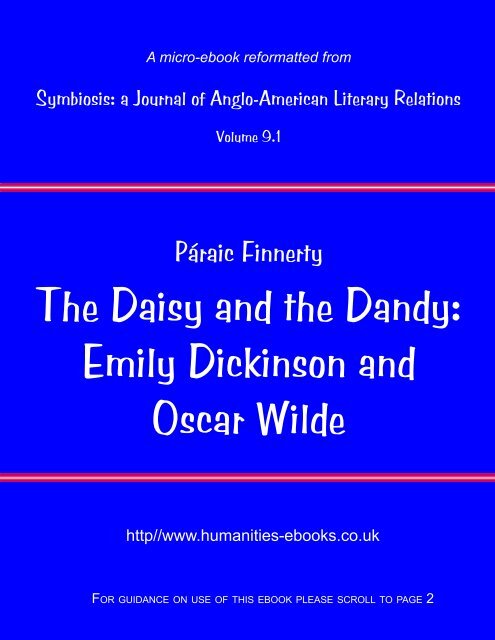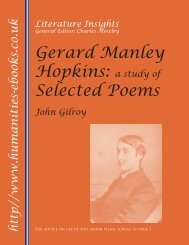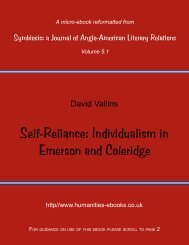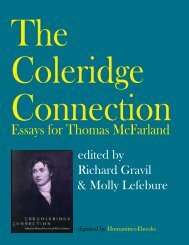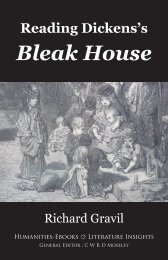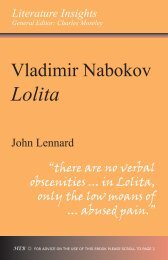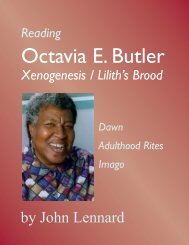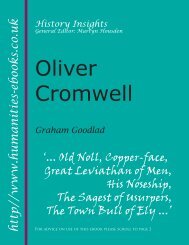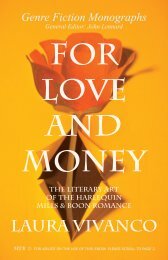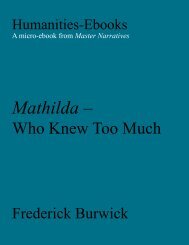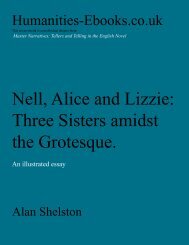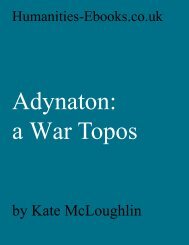The Daisy and the Dandy - Humanities-Ebooks
The Daisy and the Dandy - Humanities-Ebooks
The Daisy and the Dandy - Humanities-Ebooks
Create successful ePaper yourself
Turn your PDF publications into a flip-book with our unique Google optimized e-Paper software.
Running Head <br />
A micro-ebook reformatted from<br />
Symbiosis: a Journal of Anglo-American Literary Relations<br />
Volume 9.1<br />
Páraic Finnerty<br />
<strong>The</strong> <strong>Daisy</strong> <strong>and</strong> <strong>the</strong> D<strong>and</strong>y:<br />
Emily Dickinson <strong>and</strong><br />
Oscar Wilde<br />
http//www.humanities-ebooks.co.uk<br />
For guidance on use of this ebook please scroll to page 2
Publication Data<br />
© Symbiosis 2005, 2007 all rights reserved<br />
<strong>The</strong> Author has asserted his right to be identified as <strong>the</strong> author of this Work<br />
in accordance with <strong>the</strong> Copyright, Designs <strong>and</strong> Patents Act 1988.<br />
First published in SYMBIOSIS Volume 9.1, April 2005, pp. 63–87<br />
2nd electronic edition published in 2007 by <strong>Humanities</strong>-<strong>Ebooks</strong> LLP<br />
http://www.humanities-ebooks.co.uk<br />
Tirril Hall, Tirril, Penrith CA10 2JE<br />
Essays published in Symbiosis are subsequently digitized<br />
for <strong>the</strong> benefit of <strong>the</strong> author (80%) <strong>and</strong> <strong>the</strong> Journal (20%)<br />
Reading Options<br />
To use <strong>the</strong> toolbar this Ebook should be read in default view.<br />
To navigate use <strong>the</strong> hyperlinked ‘Bookmarks’ or thumbnails at <strong>the</strong> left of <strong>the</strong> screen.<br />
To search, click on <strong>the</strong> binocular symbol in <strong>the</strong> toolbar.<br />
Use to enlarge <strong>the</strong> page to full screen.<br />
Licence <strong>and</strong> Permissions<br />
This ebook is licensed for reading on a particular computer.<br />
<strong>The</strong> original purchaser may license <strong>the</strong> same work for a second computer<br />
by applying to support@humanities-ebooks.co.uk with proof of purchase.<br />
It is permissible to print a watermarked copy of <strong>the</strong> book for your own use.<br />
ISSN: 1362-7902<br />
A cumulative index of Symbiosis essays <strong>and</strong> reviews is online at<br />
http://www.symbiosisonline.org.uk
Páraic Finnerty<br />
<strong>The</strong> <strong>Daisy</strong> <strong>and</strong> <strong>the</strong> D<strong>and</strong>y: Emily Dickinson<br />
<strong>and</strong> Oscar Wilde<br />
Particularly during <strong>the</strong> early months of 1882, as <strong>the</strong> reclusive Emily Dickinson<br />
engaged in her daily ritual of reading <strong>The</strong> Springfield Republican, her Amherst<br />
home was invaded by <strong>the</strong> name, Oscar Wilde. 1 From <strong>the</strong> time Wilde stepped<br />
onto American soil on January 3 rd , dressed in great green coat almost down to<br />
his feet, <strong>and</strong> throughout his eleven-month lecture tour of America’s major towns<br />
<strong>and</strong> cities, America’s journalists were anxious to see, hear <strong>and</strong> record <strong>the</strong> wit of<br />
<strong>the</strong> personification of English aes<strong>the</strong>ticism. 2 Similarly, America’s leading literary<br />
<strong>and</strong> cultural figures met him, attended his lectures, or at <strong>the</strong> very least expressed<br />
<strong>the</strong>ir opinions about him. 3 Dickinson’s extant letters do not mention Wilde,<br />
<strong>and</strong> predictably she did not attend his lectures in nearby Boston or Hartford.<br />
Yet such was <strong>the</strong> publicity that his tour generated she must have been aware of<br />
what Wilde represented in America at <strong>the</strong> time. On one level, Dickinson <strong>and</strong><br />
Wilde appear to be anti<strong>the</strong>tical literary figures, embodying opposite orientations<br />
towards art <strong>and</strong> life. Yet this American poet, who spent most of her life avoiding<br />
publicity, publication <strong>and</strong> <strong>the</strong> public eye, had more in common than at first<br />
appears with <strong>the</strong> Irish self-publicist, public provocateur <strong>and</strong> first modern<br />
celebrity. 4 <strong>The</strong> following constructs a hypo<strong>the</strong>tical path-crossing between <strong>the</strong><br />
woman who dressed in white <strong>and</strong> fashioned herself as an unobtrusive, shy<br />
‘<strong>Daisy</strong>,’ <strong>and</strong> <strong>the</strong> man who, at <strong>the</strong> time, was <strong>the</strong> flamboyant d<strong>and</strong>y of aes<strong>the</strong>ticism.<br />
It surveys particular aspects of Wilde’s reception in America through reference<br />
to <strong>The</strong> Springfield Republican <strong>and</strong> to <strong>the</strong> journals Dickinson most avidly read:<br />
Harper’s New Monthly, <strong>The</strong> Atlantic Monthly <strong>and</strong> <strong>The</strong> Century. 5 It also considers<br />
<strong>the</strong> specific responses of Dickinson’s bro<strong>the</strong>r, Austin, who attended Wilde’s


